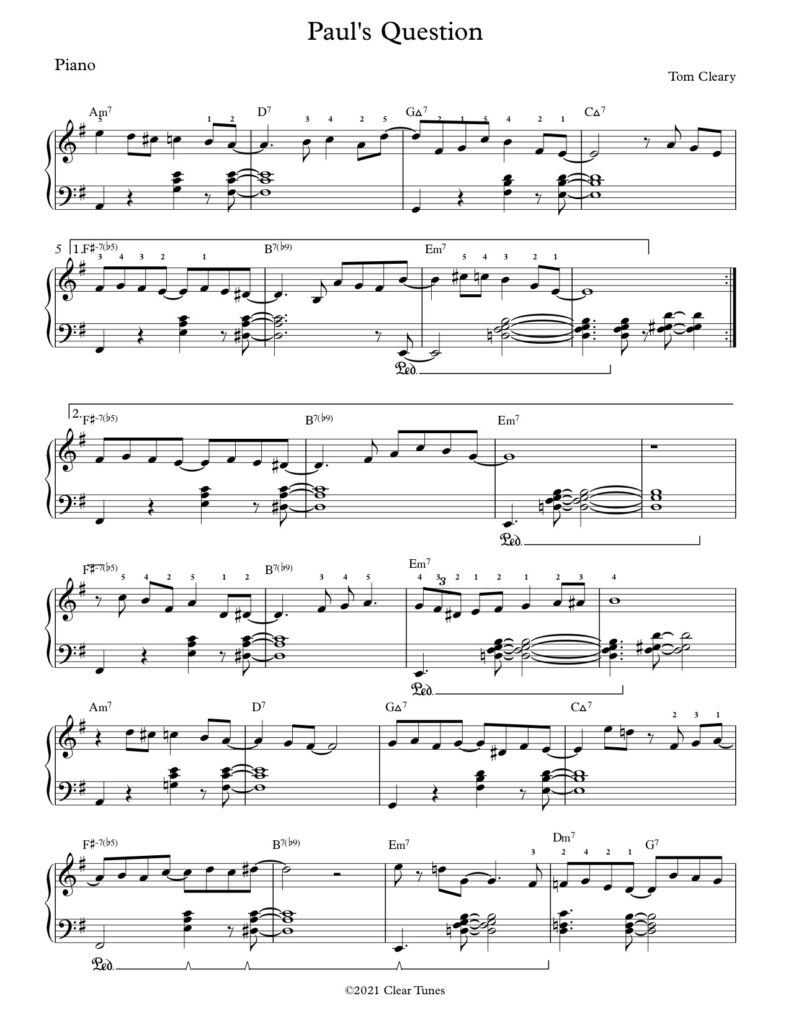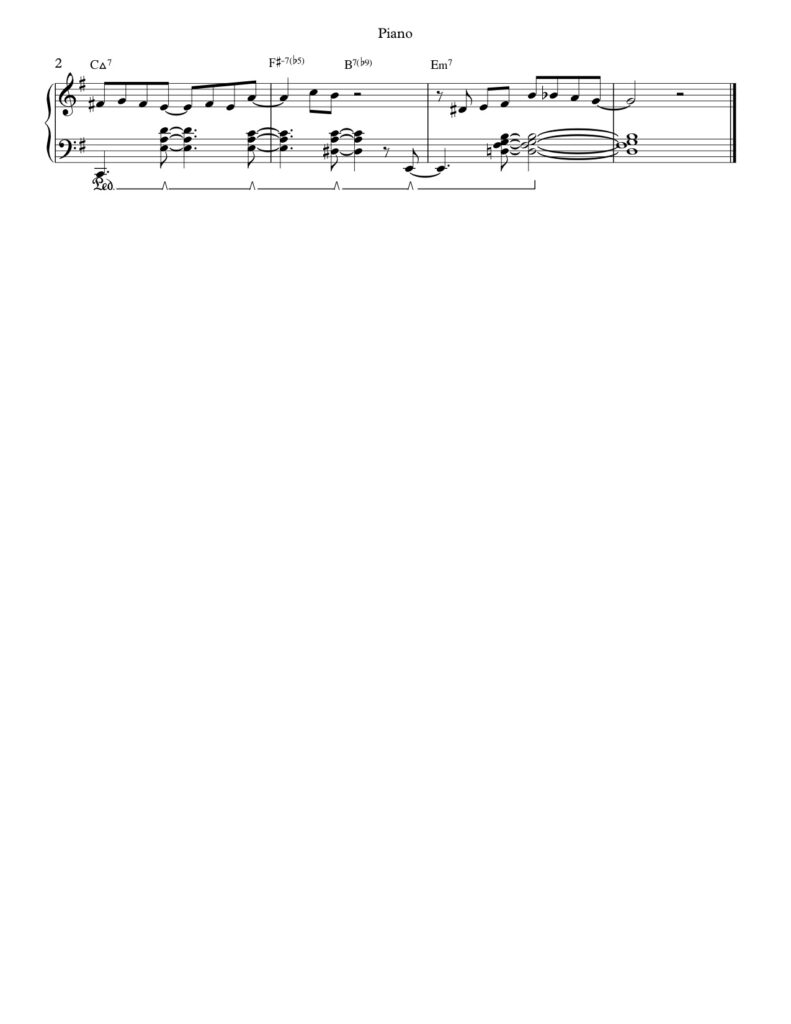Two of the most iconic jazz versions of Autumn Leaves combine the tune’s melody and chord progression with a dotted quarter-eighth note rhythmic figure sometimes called the ‘Charleston rhythm’. This term references the the James P. Johnson composition of the same title which was in turn named for a 1920s dance craze. In the Johnson piece, the dotted quarter-eighth note rhythm is heard in the melody and the accompaniment in nearly every bar of the song; this can be heard in Johnson’s playing as two notes, a short note on the downbeat of beat one and a second note on the ‘and’ of two, with a rest in between. The Charleston rhythm was adapted by composers and arrangers including James P. Johnson admirer[1] George Gershwin, who used the Charleston pattern in ‘I Got Rhythm‘ on beat two of first bar of the melody and on beat one of the second, and James P. Johnson student[2] Duke Ellington, who used the Charleston pattern in C Jam Blues on the third measure of the melody. In these tunes the pattern was adapted to be two connected notes, a dotted quarter note followed by an eighth note. Other jazz standards in which the ‘Charleston’ rhythm figures prominently include Killer Joe by Benny Golson (where it appears as it does in Johnson’s ‘Charleston’, on beat one of the first bar of the form ) as well as So What by Miles Davis and Moanin’ by Bobby Timmons (where it appears on the second half of the first bar of the form).
This is the form in which the pattern appears when Hank Jones uses it in his piano comping on Autumn Leaves in the version from Cannonball Adderley’s album ‘Somethin’ Else’ that features Miles Davis. Jones’s part does not repeat the pattern exactly, but is based around the pattern. In Jones’ piano part the rhythm is heard in yet another location, beat three of the first bar of the melody. The same rhythmic figure is used by Bill Evans in the the Bill Evans Trio version of Autumn Leaves from the classic album Portrait in Jazz. While Jones’ comping behind Miles Davis’ statement of the melody is a model of dynamically reserved accompaniment, Evans’ statement of the melody is a model of melody/accompaniment balance between the right and left hands.
The chord progression used in ‘Autumn Leaves’ is also known as the ‘diatonic cycle’ for the way it begins on the ii chord in a major key and, with a bassline that follows a pattern of ascending fourths or descending fifths, cycles through chords built on all seven notes of the major scale, landing on the relative minor. This progression was around long before the tune ‘Autumn Leaves’ was composed in 1945; it can be heard near the beginning of the Allegro from J.S. Bach’s Brandenburg Concerto No. 2. Since ‘Autumn Leaves’ was composed, the diatonic cycle progression has appeared in a number of tunes, at least some of which are likely borrowing it from Autumn Leaves; these include:
– Tito Puente’s Maria Cervantes; during the solo section of this tune, the Autumn Leaves A section changes are looped with their usual harmonic rhythm cut in half (so that each change lasts two beats instead of four) over a 2-3 son clave
– Clare Fischer’s Morning uses Autumn Leaves A section changes with a compressed harmonic rhythm over a cha-cha groove in the second four bar phrase of its A section
– The song best known as the ‘Theme from MASH’, the 1970s TV show (the title of its lesser known lyrics is ‘Suicide Is Painless’), famously interpreted by Bill Evans, uses the Autumn Leaves A section changes over a bossa nova groove. (Evans cycles the entire form of the tune through three keys, using a pattern of descending major thirds.)
– Carlos Santana’s Europa uses the Autumn Leaves A section chords over a rhythm section that combines rock ballad feel with bolero
– A good reference for the original French lyrics to Autumn Leaves (Les Feullies Mortes) is the version by Charles Aznavour, which is also a good recording to use for practicing the changes to the tune in E minor (as shown in the tune below) with the left hand alone. Aznavour also wrote an original tune, Yesterday When I Was Young, that uses the A section changes of Autumn Leaves.
– versions of Autumn Leaves by jazz pianists Ahmad Jamal and Keith Jarrett include improvised sections that are based on a minor chord vamp rather than the form, anticipating the loop-based arrangements of contemporary players like Cassandra Wilson, Dianne Reeves, Jason Moran and Robert Glasper. A recent version of Autumn Leaves by vocalist Leslie Odom Jr. bookends the tune with a vamp-based intro and outro.
My tune ‘Paul’s Question’ is named after a student who approached me after rehearsal and asked how to take a solo on Autumn Leaves. A chart and keyboard video of it is below. It combines a Charleston-based stride accompaniment in the left hand using mostly rootless voicings with a bop-based melody in the right hand. I hope this post might either inspire you to create your own piece based on an excerpt from the Autumn Leaves progression or a tune based on the entire progression of Autumn Leaves.
I encourage you to choose one recording out of the Bach, Tito Puente and Clare Fischer pieces and leave a comment citing the timing (i.e. minutes and seconds) of the place where the Autumn Leaves/diatonic cycle progression is used in that piece.
[1] See this short Johnson biography by Margaret Moos Pick for more on the Gershwin-Johnson relationship.
[2] Terry Teachout’s biography ‘Duke’ mentions that after hearing Ellington play his famously challenging Carolina Shout, Johnson ‘was sufficiently impressed to go club-hopping with his
young admirer. It was a night that Ellington never forgot: “What I absorbed on that
occasion might, I think, have constituted a whole semester in a conservatory.”


Interesting note! The song, “Homage” by Mild High Club references the chords to their song in the first couple lines, the lyrics go:
“Someone wrote this song before and I could tell you where its from, the 4 7 3 6 2 5 1 to put my mind at ease”
If we consider those numbers as chords in a minor key, it is the exact same structure as the Autumn Leaves chords. I was able to sing Autumn Leaves over this song, meaning this is another example of a song that follows the diatonic cycle pattern. I believe that the title “Homage” is pointing that the song itself is an homage to this pattern!
Hi Ben, ‘Homage’ is indeed using the progression from the A section of Autumn Leaves. Although the lyrics have a cool ring to them, the music theory they are based on is sketchy. The first four chords of Autumn Leaves are commonly understood to be a ii-V-I-IV progression in a major key, followed by a ii-V-i in the relative minor.
Autumn Leaves is such an iconic jazz standard, and it’s fascinating that its chord progression can yield to so much variation. Having been classically trained, it’s so cool to see that composers such as Bach were experimenting with these types of chord progressions all those years ago, and now there are so many tunes with the same one. I remember playing around with Bach’s music and hearing how jazzy it sounded for being written when it was. The diatonic cycle can be used in so many different ways, and in so many different genres, whether that be classical, jazz, pop, or latin jazz.